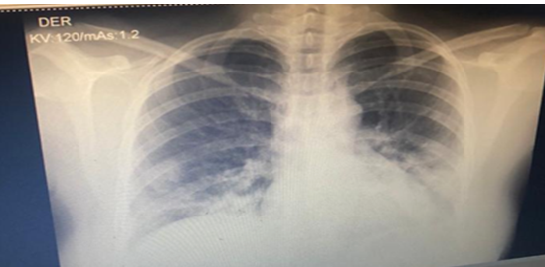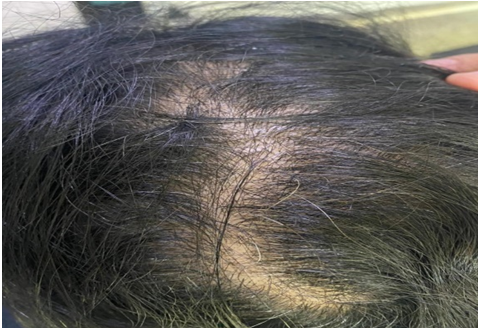Introduction
There
is growing interest in the study of cutaneous manifestations in patients with COVID-19.
Currently it is not known whether the virus is directly responsible for the
appearance of these cutaneous manifestations, among which a type of alopecia
known as telogenic effluvium stands out. The relationship between alopecia and COVID-19
is currently being investigated around the world, with scientific studies
attempting to delve into this link between the SARS-CoV-2
coronavirus
disease and hair loss in infected patients. Currently, there are several
ongoing investigations where it has been observed that more than a hundred
patients admitted for COVID-19 had a high percentage of alopecia compared to
the rest of the population. The explanation that could be behind this
relationship is that the SARS-CoV-2 virus to penetrate lung cells depends on
its adherence to the host surface-associated serine 2 transmembrane protease
protein. And precisely the expression of this protein is related to an increase
in the expression of the androgen receptor [1-4].
Case Report
This is a 41-year-old female patient who was admitted to the emergency department after presenting a clinical picture of 8 days of evolution consisting of dry cough, tachycardia and diaphoresis, for which the antigen test for SARS-CoV-2 was performed (Figure 1) revealing a positive result, so it was decided to enter for medical management. The patient, who was admitted to hospital from the emergency room with a diagnosis of SARS-CoV-2 pneumonia by positive PCR, underwent a chest X-ray (Figure 2), which revealed interstitial infiltrates with predominantly right baseline consolidations.

Figure1: SARS-CoV-2 antigen test positive.

Figure 2: Interstitial infiltrates with predominantly right basal consolidations.
It was decided to give an evaluation by internal medicine, who decided to hospitalize and indicated management with tocilizumab 600mg and oxygen by nasal cannula at 3 liters per minute. After this, protocol management was indicated for COVID-19 with Ampicillin sulbactam, Clarithromycin, Exoxaparin and IV Corticosteroid. On the third day of hospitalization, the patient began to show abundant hair loss (Figure 3) and on the seventh day of hospitalization, it was decided to discharge her due to improvement of the initial clinical picture with outpatient management with Salbutamol 100mcg, Acetylsalicylic acid 100mg, Clarithromycin 500mg and Beclomethasone 50mcg, even with the current alopecia picture.

Figure 3: Telogenic effluvium secondary to SARS-CoV-2 infection.
Discussion
Patients
who have contracted the COVID-19 disease, due to the direct action of SARS-CoV-2, would present a
sudden and abundant loss of hair, a loss that is estimated to appear up to 3
months after having overcome the disease. The toughen effluvium would lead the
patient to lose much more than the 50 to 100 hairs that usually fall out per
day. It is a transitory process that takes approximately between 4 and 6 months
to recover and from which until now there is no possibility of avoiding said
fall. According to some study reports, people who have suffered a more severe
form of COVID-19 tend to have telogen effluvium more frequently. This event is
something that happens regularly with serious infections or other exceptional
situations, such as multiple births, because the body prioritizes recovering
from the disease, which makes both nails and hair more fragile. In addition to
the infection, the stressor that has been linked to this disease should also be
emphasized, remember that stress causes an increase in adrenaline, which
increases its levels in the blood, causing an increase in cortisol, which
consequently it will cause a decrease in blood circulation and consequently an
incorrect absorption of nutrients and water by the scalp and hair follicles.
This will cause the hair to weaken and all those hairs that are in the process
of growth (anagen phase) to suddenly fall (telogen phase). In conclusion, the
report of this case should be considered as an alert to world public health, so
that this clinical presentation is considered as a possible dermatological
manifestation derived from COVID-19 [5-8].
References
1. Redondo-Sendino Á, Sánchez ICG and de Victoria FB. Skin manifestations associated with the disease by the new coronavirus SARS-CoV-2 (2020) Clinical Medicine 155: 414-415. https://doi.org/10.1016/j.medcli.2020.04.057
2. Herrera J, Peñafiel A and Rivas M. Cutaneous manifestations in the infection of COVID-19: Bibliographic review (2020). https://doi.org/10.1590/SciELOPreprints.1102
3. Roque
PL, González EM and Pérez CL. Cutaneous manifestations secondary to the
COVID-19 pandemic Presentation of a case (2020) Revista Habanera de Ciencias
Médicas 19.
4. Macias M, Zapata E, González M, Fuenzalida H, Honeyman J, et al. Recomendaciones Rama de Dermatología Pediátrica, Sociedad Chilena de Pediatría, Pandemia COVID-19 (2020) Revista chilena de pediatría 91: 43-48. http://dx.doi.org/10.32641/rchped.vi91i7.2485
5. Arenas
MÁS, del Carpio-Toia AM, Galdos JA and Rodriguez-Morales AJ. Alopecia and
severity of COVID-19: a cross-sectional study in Peru (2021) Le infezioni in
medicina 29: 37-45.
6. Gil-Redondo R, Moreno-Arrones OM, Vañó-Galván, S and Jaén-Olasolo P. Alopecia (2019) Medicine-Programa de Formación Médica Continuada Acreditado 12: 5394-5404. http://doi.org/10.1016/j.med.2019.12.002
7. González-Payares
M. COVID-19 en Iberoamérica: Un acercamiento desde la dermatología (2020) IPSA
Scientia 5: 79-87.
8. Ortega-Peña M, and González-Cuevas R. Familiar dermatologic drugs as therapies for COVID-19 (2020) Actas Dermo-Sifiliográficas 112: 118-126. https://doi.org/10.1016/j.ad.2020.09.004
Corresponding author
Juan Tafur Delgado, Second-year pediatric resident,
University of Sinú, Colombia, Email: Juanestade93@gmail.com
Citation
Delgado JT, Ortiz MM, Marrugo VO and Gómez JF. Alopecia by COVID-19: about a case (2021) J Obesity and Diabetes 5: 1-2.
Keywords
SARS-CoV-2, COVID-19, Alopecia, Tocilizumab


 PDF
PDF